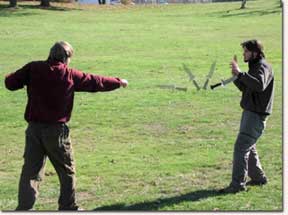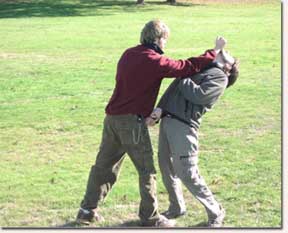Knife Fighting Throws During a Fight
Knife Fighting — Throw During the Fight
by Keith Pascal
What would you do, if your attacker dodged the throw of your weapon at him or her?
If you count on the fact that your knife throw will do damage and end the fight, you could get into a lot of trouble. Instead of piercing your attacker’s skin, your attacker dodges his head slightly to the side and your knife wizzes past.
Your self-defense move is now … over.
Should the rule be to avoid throwing your knife … always?
(I’ll answer that question in a minute.)
What if your attacker’s face is just inches from your blade? And what if you feel, that you could just flick it right into a vulnerable area?
Should you go for it and throw the knife [legal ramifications aside]?
What if your attacker dodges, and woosh — the knife is gone?
What do you do to make knife throwing an effective tactic?
First, don’t count on your tactic to work.
You should never be afraid of losing your weapon. Don’t use it as a crutch.
Be just as comfortable fighting empty handed, as you are holding a knife. Then you don’t care as much if you lose it.
This means always be willing to give up the knife, if you gain some sort of tactical advantage. For example …
The Rhythm of the Attack
Don’t wait for the next ‘beat’ in your opponent’s rhythm to launch your attack.
 Many martial artists don’t throw the knife immediately. They wait to see what kind of damage they’ve done, and THEN they enter with their next attack.
Many martial artists don’t throw the knife immediately. They wait to see what kind of damage they’ve done, and THEN they enter with their next attack.
You throw and then start attacking as soon as the knife leaves your hand.
More Than Knife Throwing
Don’t limit your thinking to just throwing a knife. Toss whatever will disrupt your attacker’s rhythm. This allows you to launch your almost-simultaneous attack with your hands and feet. Launch a paperweight. Grab a chair and hurl it. Is there anything in your pocket, like loose change? Could you fling a small, hanging picture in a glass frame? (No works of art, please — just photos 😉 )
If your attacker has to deal with the thrown projectile, then he can’t be dealing with your martial arts attack at the same time. If you think in terms of distracting while attacking, you will be more successful.
If you have successfully distracted your opponent, you should be able to follow with a couple of quick hits. And if you can take advantage of these quick offensive hits, you should be able to follow up with a controlling wrist lock.
Immediate Counterattack
The idea is that you start an offensive attack the minute you throw your object.
Then you quickly follow with some hits. These strikes continue the distraction, loosen up your attacker, confuse your enemy, and allow you to move closer.
The whole time you are hitting, your arms are working in unison to be able to feel the beginnings of one or more of your locks. The second you have that painful control past the point of no return (see my book, Wrist Locks), the fight is over….
Let me end this article by saying that this type of control is almost a necessity if you have more than one attacker. While you have one attacker under your control, you get to use this attacker as a shield from the other(s).
Then you employ more of your techniques to move on to the new threat.
You created an advantage when you jumped in mid-beat, after the knife (or object) throw. Then you took that small edge, and multiplied it … into a full-on martial-arts advantage.
 Keith Pascal is the author of 10 Days to Better Knife Fighting, Blur Smith: The Greatest Knife Fighter in The World, and KNife Fighting Tips. If you haven’t read 10 Days to Better Knife Fighting, then you probably don’t know all of these efficient ways to increase your knife fighting skills.
Keith Pascal is the author of 10 Days to Better Knife Fighting, Blur Smith: The Greatest Knife Fighter in The World, and KNife Fighting Tips. If you haven’t read 10 Days to Better Knife Fighting, then you probably don’t know all of these efficient ways to increase your knife fighting skills.
Tags: knife fighting, knife throw follow-up, martial arts, throwing knife in fight


